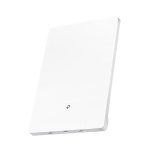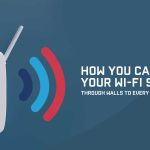To instantly improve your WiFi signal, consider repositioning your router to a central, open spot, updating its firmware, or adding a WiFi extender. Simple tweaks like these can significantly enhance your connection speed and stability.
Boosting your WiFi signal might seem tricky, but with a few smart adjustments, you can enjoy faster, more reliable internet throughout your home. First, placing your router in a central location away from obstructions is key—avoid hiding it in closets or corners. Updating your router’s firmware ensures optimal performance and security. If your signal still struggles in certain areas, using WiFi extenders or mesh networks can expand coverage effortlessly. Small changes can have a big impact, making your online experience smoother and frustration-free. Whether you’re working, gaming, or streaming, a stronger WiFi connection keeps everything running seamlessly, and these simple steps will get you there.
How to Boost WiFi Router Signal: Effective Tips and Tricks
Understanding WiFi Signal Strength and Why It Matters
A strong WiFi signal ensures faster internet speeds and reliable connections across your home or office. When your WiFi is weak, you might experience frustrating lag, dropped connections, or slow downloads. Knowing what affects WiFi signal strength is the first step to improving it.
Factors like distance from the router, physical obstacles, and interference from other electronic devices can all weaken WiFi signals. By addressing these issues, you can make sure your internet runs smoothly everywhere you need it.
Place Your Router in the Right Location
The position of your WiFi router plays a big role in its signal coverage. Place the router in a central spot in your home to maximize reach. Avoid putting it in a corner or behind furniture where signals can be blocked.
Keep it elevated, such as on a shelf or high table, to reduce interference from furniture or appliances. Also, avoid placing it near large metal objects, microwaves, or cordless phones that can interfere with WiFi signals.
Adjust Your Router’s Antennas
Most routers come with adjustable antennas that can improve signal distribution. If your router has external antennas, try positioning them vertically for better coverage across floors.
For optimal results, angle some antennas horizontally and others vertically. This can help you reach devices located at different heights and directions in your space.
Use WiFi Range Extenders or Mesh Networks
When your WiFi doesn’t reach every corner, consider adding a WiFi extender or mesh network system. These devices help amplify signals and eliminate dead zones.
Range extenders repeat the WiFi signal from your router, making it stronger in distant areas. Mesh networks create multiple access points, providing seamless coverage throughout large spaces.
Update Router Firmware and Settings
Keeping your router’s firmware updated ensures it runs efficiently and securely. Manufacturers often release updates that improve performance and fix bugs.
Access your router’s admin panel to check for firmware updates. Also, consider adjusting settings like the broadcast channel to avoid interference from neighboring networks.
Change WiFi Channels to Reduce Interference
WiFi channels are like lanes on a highway; overlapping lanes can cause congestion and slowdowns. Use tools or your router’s interface to identify less congested channels.
Switch to a channel with fewer overlapping networks, especially if you notice slow speeds during peak times. For 2.4 GHz networks, channels 1, 6, and 11 are most common, but choosing the least crowded among them helps.
Switch to the 5 GHz Band
If your router supports dual-band WiFi, using the 5 GHz band can significantly boost speed and reduce interference. It is less crowded than the 2.4 GHz band, especially in busy neighborhoods.
However, 5 GHz signals have a shorter range. Place your router closer to devices that need high-speed connections, or use dual-band to connect multiple devices efficiently.
Optimize WiFi Settings for Better Performance
Adjust your router’s settings to improve speed and stability. Enable Quality of Service (QoS) to prioritize bandwidth for important applications like video calls or gaming.
Disable any unused features or unnecessary WiFi bands that may cause congestion. Experiment with different settings to find what works best for your environment.
Secure Your WiFi Network
An open or weakly secured WiFi network can invite unauthorized users, slowing your connection and risking security. Use strong encryption like WPA2 or WPA3 to protect your network.
Change the default admin password and disable WPS to prevent unauthorized access. Secure networks ensure only trusted devices connect, maintaining optimal performance.
Limit the Number of Devices Connected
Too many devices using your WiFi can strain your network and slow speeds. Disconnect any devices not in use and consider upgrading your plan if multiple users need high bandwidth.
Use the router’s admin panel to see which devices are connected and remove those that aren’t needed. Managing device connections helps maintain a fast and stable network.
Upgrade Your Router if Necessary
If your router is outdated or too low-end, it may struggle to provide good coverage or high speeds. Consider investing in a newer, more powerful model designed for larger spaces.
Look for routers with higher data transfer rates, better antennas, and support for the latest standards like WiFi 6. This ensures your network can handle multiple devices and high-bandwidth activities smoothly.
Additional Tips for Improving WiFi Signal
- Use a wired Ethernet connection for stationary devices to free up WiFi bandwidth.
- Remove physical barriers such as thick walls or large furniture near your router.
- Perform regular speed tests to monitor your network performance.
- Restart your router periodically to clear cache and improve signal stability.
Related Topics to Explore
How to secure your WiFi network against hackers
Best WiFi extenders and mesh systems in 2024
Understanding WiFi frequency bands and standards
Tips to reduce WiFi interference from neighboring networks
Improving your WiFi signal doesn’t require complicated steps. With the right placement, updates, and adjustments, you can enjoy faster, more reliable internet throughout your space. Focus on these strategies to make your WiFi stronger and better suited to your needs.
DON'T Buy A Wi-Fi Range Extender!
Frequently Asked Questions
What steps can I take to reduce interference with my Wi-Fi signal?
To minimize interference, keep your router away from other electronic devices like cordless phones, microwaves, and Bluetooth gadgets. Place your router in a central location, preferably elevated, to improve coverage. Avoid positioning it near thick walls or metal objects, as these can block or weaken the signal. Using the 5 GHz band instead of the 2.4 GHz band can also reduce interference from other networks and devices.
How does the placement of my router affect Wi-Fi performance?
Router placement significantly impacts signal strength and coverage. Position your router in a central, open area to ensure even distribution of the wireless signal throughout your space. Keep it elevated, such as on a shelf or high table, to avoid obstructions. Avoid placing it near large metal objects, appliances, or inside cabinets, which can diminish signal quality. Proper placement ensures stronger, more reliable Wi-Fi connections.
Are there specific settings I should optimize on my router to boost the signal?
Yes, adjusting your router’s settings can improve signal strength. Use the latest firmware update to ensure optimal performance. Change the Wi-Fi channel to one with less congestion, especially on the 2.4 GHz band, to enhance connectivity. Enable both 2.4 GHz and 5 GHz bands if your router supports dual-band operation and connect devices accordingly. Disabling unused features and reducing interference from other devices can also help strengthen your Wi-Fi signal.
Is updating my router’s firmware beneficial for improving signal strength?
Updating your router’s firmware can significantly enhance its performance and stability. Manufacturers often release updates that fix bugs, improve security, and optimize signal transmission. Regularly check for firmware updates through your router’s admin interface or the manufacturer’s website. Keeping your firmware current ensures your device runs smoothly and can help improve overall Wi-Fi signal quality.
Can using Wi-Fi extenders or mesh networks help in boosting signal coverage?
Using Wi-Fi extenders or setting up a mesh network can expand your Wi-Fi coverage effectively. Extenders amplify the existing signal and relay it to distant areas, reducing dead zones. Mesh networks create a seamless Wi-Fi system with multiple access points, providing consistent coverage across large spaces. These solutions are especially useful in large homes or offices where a single router cannot cover the entire area adequately.
Final Thoughts
To boost wifi router signal, start by placing your router in a central location away from obstructions. Update your router’s firmware regularly to improve performance. Additionally, reducing the number of connected devices can significantly enhance your connection quality.
Using a Wi-Fi extender or mesh system can also help expand your coverage area. Experiment with different channel settings to minimize interference.
In conclusion, understanding how to boost wifi router signal involves optimizing placement, updating firmware, and managing device connectivity. Applying these simple tips will strengthen your Wi-Fi signal and ensure a smoother online experience.




